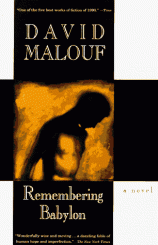Reading Group Guide
Discussion Questions
Remembering Babylon

1. Malouf tells his story in an intermittent and at times circuitous manner. Typically, he reports the essentials of an incident, traces its repercussions through different witnesses, and then returns to fill in its missing details--particularly, the actions and motivations of his central character. Where else does Malouf employ this narrative strategy? What does he accomplish by telling his story from shifting points of view and by withholding critical revelations?
2. In contrast to his use of multiple points of view, the author employs a stable and somewhat distanced narrative voice. That voice can express profound and often lyrical insights into each of the novel's characters, yet it belongs to none of them. How does the tension between a fixed, omniscient voice and shifting, limited points of view affect your perception of the novel's events?
3. Lachlan and his cousins first encounter Gemmy while pretending to hunt wolves on the Russian steppes. What irony is implicit in this game? Where else in Remembering Babylon do characters behave as though they were somewhere other than the Queensland bush? What are the consequences of this tendency?
4. Lachlan "captures" Gemmy with an imaginary weapon, a stick masquerading as a gun. Why does Gemmy surrender? What power does he recognize in this object and in the gesture that animates it? Where else in Remembering Babylon do simple objects acquire magical power?
5. To the children, the landscape from which Gemmy emerges is "the abode of everything savage and fearsome, and since it lay so far beyond experience, not just their own but their parents' too, of nightmare, rumours, superstitions and all that belonged to Absolute Dark." [p. 3] How is this initial description amplified or altered in the course of the novel? At what moments does the landscape seem to physically permeate its inhabitants, as, for example, on page 18, where Abbot feels his blood beating in unison with the shrilling of insects in the bush?
6. How do Gemmy and his aboriginal rescuers view the same landscape? What language does Malouf use to convey their differing perceptions? Which vision of the land triumphs by the novel's climax? At what points--and through what agency--do some of the novel's English characters come to see the Australian terrain as Gemmy does?
7. Gemmy's first words are "Do not shoot. I am a B-b-british object!" [p. 3] What does it mean to be an object rather than a subject? What meanings accrue to this phrase in light of Gemmy's experience as a child in England--and as a man-child in a white settlement in Australia?
8. Gemmy returns to his countrymen at a certain moment in Australian history, at a time when settlement in Queensland has advanced only halfway up the coast and many villages--including the one in which the action unfolds--are still unnamed. How has Australia changed by the novel's climax? What is the implied relation between Gemmy's fate and the progress of Australian history?
9. The fact that Gemmy is first seen balanced precariously on a fence is indicative of his status as an "in-between creature" [p. 28], poised between European and aboriginal identities. How does Gemmy's treatment by the aborigines both parallel and differ from his treatment by Englishmen? How does Gemmy view himself? What other hybrids or transitions does he embody?
10. Language plays a critical role within this novel, beginning with Gemmy's sense that the words in which Abbot transcribes his story contain "the whole of what he was" [p. 20]. At what other points in the book does the spoken or written word act as a magical shorthand, one that not only connotes but invokes and transforms reality? How does Malouf's prose style mirror this effect? How does the novel's sense of language parallel its vision of objects and landscape?
11. It is tempting to see Gemmy as an innocent. But has Gemmy merely stumbled into colonial territory or has he come there with a purpose--and, if so, what is it? Is your earlier sense of Gemmy altered by the discovery that, as a boy in England, he may have killed his master?
12. Behind every imposture lies a second self. In Gemmy's case, that other self is the one that lies dormant during his life with the aborigines and that first surfaces when he tastes the mash that Ellen McIvor is throwing to her chickens [p. 31]. How does Malouf describe the interplay between his characters' different selves? Which of his characters realize their inner selves by the novel's end?
13. In the course of Remembering Babylon, certain characters change, not only in relation to Gemmy, but in relation to each other. Where, and in whom, do these changes occur? To what extent is Gemmy the cause of these transformations?
14. Repetition is an essential part of this novel's structure. It is not just that certain incidents--Gemmy's fall from the fence, his meeting with the aborigines--are narrated from different points of view. In Remembering Babylon episodes and objects have a way of doubling. What is the effect of these multiplications? How do they constitute a cyclical counterpoint to the linear progression of the narrative?
15. By the simple fact of his presence, Gemmy divides his hosts into two camps: those who tolerate and in time love him, and those who are determined to drive him away. What is it that distinguishes Gemmy's protectors from his tormentors? What qualities do the two groups have in common?
16. Although Malouf tells his story from multiple points of view and tells us much about characters as diverse as a thirteen-year-old boy, a middle-aged farm wife, and an otherworldly parson, he leaves his aboriginal characters enigmas. We know them only through Gemmy, who has lived among them but is not entirely of them. Why might Malouf have chosen to do this? What is the effect of this gap in the novel's psychological fabric?
17. Nature is one of this novel's central mysteries, not only in the form of the land, with its strange life-forms and reversed seasons, but in its human aspect. The Reverend Frazer describes Gemmy as someone who "has crossed the boundaries of his given nature." [p. 132] What vision of human nature does Remembering Babylon present? What is the implied relationship between human nature and the natural world?
18. What is the "Babylon" of this novel's title? What "Jerusalem" does Malouf suggest as its counterpart?
Remembering Babylon
- Publication Date: October 4, 1994
- Paperback: 224 pages
- Publisher: Vintage
- ISBN-10: 0679749519
- ISBN-13: 9780679749516







